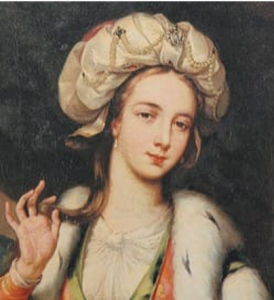While in Turkey, Lady Mary Wortley Montagu (26 May 1689 – 21 August 1762) came across the process of variolation, as it was practiced amongst the people of Constantinople. She first mentioned variolation in the famous letter to her friend, Sarah Chiswell, in April 1717.

“I am going to tell you a thing, that will make you wish yourself here. The small-pox, so fatal, and so general amongst us, is here entirely harmless, by the invention of engrafting, which is the term they give it. There is a set of old women, who make it their business to perform the operation, every autumn, in the month of September, when the great heat is abated. People send to one another to know if any of their family has a mind to have the small-pox; they make parties for this purpose, and when they are met (commonly fifteen or sixteen together) the old women comes with a nut-shell full of the matter of the best sort of smallpox, and asks what veins you please to have opened. She immediately rips open that, you offer to her, with a large needle (which gives you no more pain than a common scratch) and puts into the vein, as much matter as can lie upon the head of her needle, and after that, binds up the little wound with a hollow bit of shell, and in this manner opens four or five veins.”
Through her detailed description, Lady Mary Wortley Montagu provides instructions on how to replicate the process and slow the spread of smallpox, a highly infectious disease which killed many Europeans. Lady Mary Wortley Montagu had a special interest in a cure for smallpox as she suffered from the disease losing her beauty, and almost her life, when fighting the disease prior to her travels to Turkey in 1715. Her belief in the success of the process is understood as she inoculates her son against the advice of her European travel companions while in Constantinople. She does not have her daughter inoculated at that time; however, when an outbreak of smallpox occurs on their return to London, she has her daughter engrafted.1 When Lady Mary Wortley Montagu has this medical procedure performed on her daughter, she invites multiple physicians to view the process and oversee her daughter’s progress.
Lady Mary Wortley Montagu provides one of the first written accounts of the process of engrafting. In addition, her letters are significant as they represent the incorporation of Eastern medicine into Western cultures. Often, Western cultures are close-minded to incorporate Eastern medicine processes or natural medicine, and Lady Mary Montagu shifted this attitude by bringing engrafting to London. Her example reminds me to remain aware of new possibilities and treatments outside of Western contexts. Lady Mary Wortley Montagu’s open-mindedness to medical practices outside of Western culture allowed her to bring recognition to a life-saving treatment to smallpox.

 0
0
